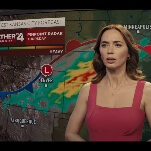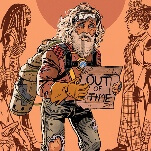Is a world as crummy as Dark Souls’ really worth saving?
Let It Rot
In my review of Dark Souls III, I grappled with the series’ obsession with cycles. It’s a theme that makes for fascinating discussion and mythology, but it’s also a nice narrative explanation for why the series has repeatedly invoked the same character and location archetypes. For the most part, all you ever get to see are ruined towns and churches and the deadly wilds that surround them, yet you’re tasked—in rather vague terms—with seeking out a method to ensure the continued survival of this land and its people. So The Space Pope had to wonder, are these places really worth saving?
So does anybody actually live in these beautiful, bleak, doomed worlds? This style of game really isn’t my thing, but I’m curious about the setting. Whenever a game or story or what have you is set in one of these “dark fantasy” worlds, where everything’s covered in mud and there are zombies and cursed knights around every corner, I have to ask: Why exactly is this world worth saving? Who am I saving it for? Do people still farm and trade and build? Are there towns full of people depending on heroes to save them? Or is everyone just another shambling revenant, going through the motions of life that have long since lost their meaning, like the countless enemies who seem to just sit around all day waiting for some random yahoo to wander by and be disemboweled? If this is preferable to the apocalypse, then what the hell is an apocalypse?
I had a similar problem with the Dragon Age games initially. They’re fun to play, but as I learned more about Ferelden, I had to ask if this was a world that was really worth all this effort. Everyone’s racist, doing magic gets you either a leash or a demonic possession, and the ground is full of monsters who are guaranteed to show up and wreck everyone’s shit every few years. Eventually I got over it and enjoyed the games for what they are, but the general principle still nags at me. I’m all for complexity and shades of gray in my fantasy worlds, but it’s not much fun to play around in a world that’s nothing but gray.
Dark Souls’ mythology is infamously obscure, but several commenters stepped up to try and answer this question (myself included, although my answer is a little more concerned with interpreting the broader implications of “saving” and “not saving” this world). Here’s Drinking_With _Skeletons’ explanation:
The Souls games are always set in ruined areas to which your character travels, and your character is always somehow set apart from the general populace. In DS and DS2, you are an undead striving to end the curse of the undead, and you have to travel to forgotten regions to do so. This is especially highlighted in DS2‘s introduction video. The characters you meet are also from other regions and often discuss the reason they set out on their own quest. It’s usually for a similar reason.
Having said that, there are some signs that the worlds in DS and DS2 aren’t bound by normal laws of time and space. The whole cooperative aspect is explained as pulling people from alternate realities into yours, and based on the geography of DS2 and some subtler signs in DS1, I suspect that not all areas of the world you explore exist in the same timeline and/or dimension.
So in short, the areas you explore aren’t places where civilization really exists, but the world continues on outside of them.
As for the other fantasy series The Space Pope mentioned, Grumproro recalled being similarly torn:
I sometimes felt like that with the Dragon Age games too. I like that Inquisition was actively trying to get you to question whether or not any of this was worth saving in the end. And as someone who plays as an elf, I kind of wanted to watch the world burn. But by the end of each game I always feel like I want to save the world for the sake of my character’s love interest. So at least they have that? I don’t know much about the Dark Souls games, but I assume there’s no romance.




























![Rob Reiner's son booked for murder amid homicide investigation [Updated]](https://img.pastemagazine.com/wp-content/avuploads/2025/12/15131025/MixCollage-15-Dec-2025-01-10-PM-9121.jpg)











